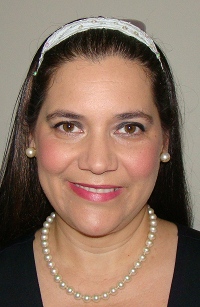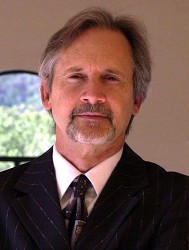Posted by Elena del Valle on October 5, 2011
By Jennifer Dublino, chief operating officer, Scent Marketing Institute

Jennifer Dublino, chief operating officer, Scent Marketing Institute
Photo: Scent Marketing Institute
Go to any Latin American country or Latino community in the U.S. and you will find that you are immersed in a multi-sensory experience. Colors seem more vibrant, music more dramatic, tastes more distinctive and the smells more heady.
I was born in Miami, and while not a Latina myself, grew up immersed in a delicious mix of various South and Central American and Caribbean cultures, with Cuban being predominant. Along with their close family ties and warmth, one of the things I love about Latinos is their passion for fully experiencing the world through the senses.
While each of the senses, to one extent or another, influences our behavior and mood, scent is the most powerful of our five senses after sight. Yet, when it comes to marketing, scent is often neglected in favor of solely visual and audio messages. When brands want to appeal to the large and growing Hispanic market in the US, this narrow use of the senses can be a big mistake.
Read the entire article Scent Marketing Connects to Hispanics on a Deep Cultural Level
Posted by Elena del Valle on September 28, 2011
By Lloyd Chapman
President
American Small Business League

Lloyd Chapman, president, American Small Business League
Photo: American Small Business League
Small businesses are the backbone of the American economy. There are more than 27 million of them and the latest U.S. Census Bureau data tells us that they create 90 percent of all net new jobs. Small businesses are responsible for half the private sector workforce, half of gross domestic product and more than 90 percent of U.S. exports. Also, 98 percent of U.S. companies have less than 100 employees. Yet policymakers either fail to realize this or flat out ignore it. Since 2009, small businesses have received a very small portion of stimulus dollars, while billions have gone to big banks and large corporations.
In 1953 Congress passed the Small Business Act, requiring a percentage of federal contracts to be awarded to small businesses (Currently set at 23 percent). This was a unique approach to economic stimulus. Congress basically decided to use the federal government, being the largest purchaser of goods and services in the world, to stimulate the economy by directing infrastructure spending to the nation’s chief job creators.
Click to read the entire article Small businesses can fix economy if Washington lets them
Posted by Elena del Valle on July 13, 2011
The Antivirus Bombshell
By Stu Sjouwerman
Founder and CEO KnowBe4

Stu Sjouwerman, founder, KnowBe4
Photo: CEO KnowBe4
It is said that “what you don’t know can’t hurt you” – well, that statement is proven false again by the antivirus industry. Almost anyone you ask about protecting their PC from cybercrime will almost invariably answer by saying something like “my antivirus software is all the protection I require…”
That belief could be no further from the truth. Despite the claims touted by the companies hocking antivirus software, many of their products are not very effective. Many of the best-selling antivirus suites are protecting against no more than 80% to 90% of the threats being dished out by cybercriminals.
Click here to read the entire article What You Don’t Know Does Hurt
Posted by Elena del Valle on June 29, 2011
By Bill Hettinger, Ph.D.

Bill Hettinger, Ph.D., author, Finance Without Fear
Photo: Bill Hettinger, Ph.D.
Most business owners are forever looking for a way to compete effectively in the marketplace.
In today’s world there are really two types of strategies used by businesses, operational centric and customer centric.
An operational centric business focuses on providing its products to the market at the lowest possible cost. This is the business strategy that characterizes Wal-Mart and many of the other big box retailers. They are interested in offering the lowest prices and their product offerings and customer service decisions are made with an eye towards being as operationally efficient as possible.
Contrast this with a customer centric business strategy. A customer centric business focuses first on meeting the needs of the customer and uses strategies such as customer service, sales and marketing, innovation and design, and unique product offerings to meet the needs of the customer.
Click to read the entire article Build a Profitable Business with a Niche Strategy
Posted by Elena del Valle on May 25, 2011
By Jorge Bauermeister
Communications attorney

Jorge Bauermeister, communications attorney
Photo: Jorge Bauermeister
In our increasingly interconnected and globalized marketplace, access to broadband technologies has become a prerequisite for success for individuals, businesses and communities. Broadband attracts investment and facilitates the exchange of ideas, information and goods.
Unfortunately, many underserved and minority communities, including Hispanics, are getting left behind because of the persistence of the “digital divide.” The divide exists because minority communities lack reliable access to Internet at home, school and work.
But could the expansion of broadband be the great equalizer? Many experts think so, and they are turning to creative solutions to make expanded broadband access for all a reality.
In a recent post on Mashable, Aliza Sherman highlights several U.S. cities that have launched partnerships with local nonprofit organizations and businesses to bring increased access to underserved communities.1
Click to read the entire article Broadband Access for Hispanics: The Great Equalizer?
Posted by Elena del Valle on April 27, 2011
By Catherine Lovell
Consumer behavior analyst
Varga Media Solutions

Catherine Lovell, consumer behavior analyst, Varga Media Solutions
Photo: Varga Media Solutions
The growth of the Hispanic market is certainly not a secret. In fact, this market is expected to account for nearly 11% of the nation’s total buying power by 2015 according to the Selig Center for Economic Growth. Many marketers have been anxiously awaiting the 2010 census results to assist in devising marketing plans that accommodate the emerging Hispanic market. What most of these marketers don’t realize is the data compiled by the census has never been more inadequate in pinpointing today’s Hispanic shopper.
In 2010 the U.S. Census Bureau sent out surveys by mail to households in order to estimate their base counts for the next decade. These counts rely upon each household accurately filling out a data questionnaire and then mailing it back to be compiled and modeled over the next ten years. Once the results are published, there are several data compilers who specialize in updating census data for small area geographies in between the 10 year census periods. These companies blend the census data with other inputs, using it to create estimates of consumer demand and segmentation, otherwise known as “modeled data”.
Click to read the entire article Don’t Rely on Census Bureau Survey Results to Drive Your Hispanic Targeting
Posted by Elena del Valle on April 20, 2011
By Eric Granof
Chief marketing officer
ExpertBail

Eric Granof, chief marketing officer, ExpertBail
Photos and video: ExpertBail
Building a brand is never an easy challenge, but doing so in the context of an industry that already has a negative image, can be nothing short of daunting. Add to this, an extremely popular television program that supports the negative stereotype and even worse, a long history of Hollywood romanticizing and perpetuating the negative stereotype of your industry and you can begin to see the complexity and magnitude of the challenge that our team at AIA, the nation’s largest underwriter of bail bonds, was faced with only 7 short months ago when we launched ExpertBail.
The bail bond industry is a very interesting one. Not only has it been misrepresented by the media, but it is also extremely misunderstood by the average person on the street. This is probably due to the fact that most people don’t ever expect or plan on needing a bail bond. So when they do need one, the experience is preceded with fear and uncertainty. We felt it was time to eliminate those negative feelings and replace them with new ones of trust, hope and confidence.
Click to read the entire article With video – Building a Brand and Breaking a Stereotype
Posted by Elena del Valle on March 9, 2011
By Patria de Lancer Julnes, Ph.D.

Patria de Lancer Julnes, Ph.D.
According to 2009 census estimates Hispanics1 comprise the largest minority group among, 15.8% or 48.4 million people and expected to continue growing. In spite of the size and rapid growth of the Hispanic population, for a long time Hispanics have been considered a sleeping giant, a label that, according to Cristina Beltran (2010), evokes the notion that Hispanics are “subjects on the cusp of political power and influence” (p. 3), but also a group who is “politically passive and difficult to mobilize: the giant who cannot be roused from its slumber” (p.4).
However, in a recent book, journalist Jorge Ramos (2005) challenges the image of Hispanics as a sleeping giant, arguing that Hispanics not only are now able to decide closely contested electoral races, but also that because of their size, important decisions will require the support of Hispanics. Ramos predicts that the “Hispanic vote will cease to be a weightless player on the political scale, and instead become the veritable ‘big boy’ in states and regions where the Latino vote has historically congregated” (p. xviii).The results of the 2010 midterm election, when for the first time three Hispanic candidates won top state level posts, seem to confirm Ramo’s predictions.
Click here to read To awake sleeping giants, invite them to play for real
Posted by Elena del Valle on March 2, 2011
By Jacquelyn Ottoman
Author, The New Rules of Green Marketing

Jacquelyn Ottoman
First the secret: Latinos are just as likely as Whites and Asians to be “green” consumers! According to the Natural Marketing Institute, a respected marketing research firm, in 2009, Latinos represented 4% of U.S. population—and 4% of U.S. green consumers, too. What’s more, green Latinos tended to be equally distributed among the same types of green segments as Whites and Asians: LOHAS (Lifestyles of Health and Sustainability) – 4%, Naturalites 1%, Drifters (status-conscious) – 4%, Conventionals (resource conservers) 4%, and Unconcerned 3%.
This means that marketers targeting the Hispanic market with the high quality products that Latinos seek, need to heed the same myths of green marketing as the White and Asian marketplaces. These myths of green marketing, as I describe in more depth in my new book, The New Rules of Green Marketing Strategies, Tools and Inspiration for Sustainable Branding include:
Myth #1 Green products don’t work as well.
Fact: Method, Tide Coldwater, and Clorox Greenworks brands have been developed specifically to work as well or better than regular products—and command a slight premium price to boot!
Click to read the entire article Eight Myths About Green Products and a Secret About the Hispanic Marketplace
Posted by Elena del Valle on February 23, 2011
Putting story power to work in the Hispanic marketplace
By Bonnie Buckner and Pamela Rutledge, Ph.D.
Co-founders, A Think Lab


Bonnie Buckner and Pamela Rutledge, Ph.D.
Photos: Bonnie Buckner and Pamela Rutledge, Ph.D.
The explosion of new technologies and social media has created expanded opportunities for marketers and public relations professionals to reach both more pointed and more diverse audiences. There is a tendency to focus on the technology or the tools, but substance drives an effective campaign. Stories deliver substance. They provide an authentic human experience that taps into psychological fundamentals and the richness of culture, making them the most effective way to engage audiences. Stories have the ability to express the essence of a brand or advocacy campaign. They are how we make sense of the world, how we connect, and how we share.
The Hispanic marketplace is rich and diverse, consisting of many different cultures from countries in Central and South America, the Caribbean and Spain with many different levels of acculturation and assimilation. Stories are a way to bridge cultural diversity because culture is story. In a Hispanic marketplace rich with cultural histories, story is a powerful means to engage people in a meaningful way.
Click to read the entire article Transmedia Storytelling





















